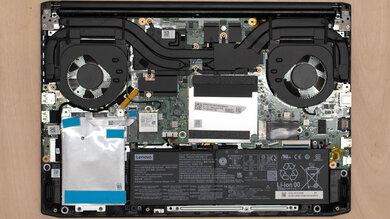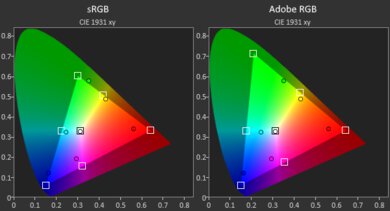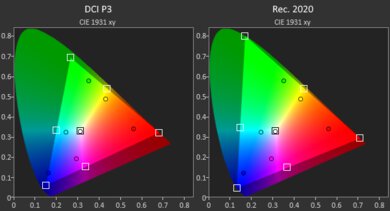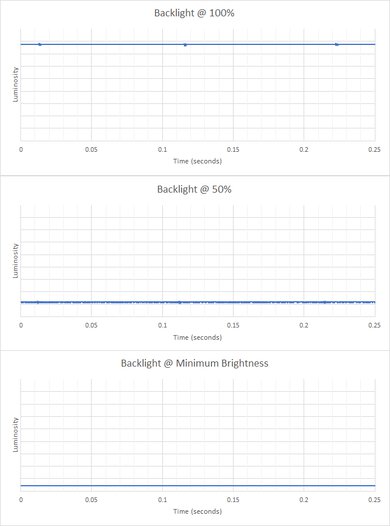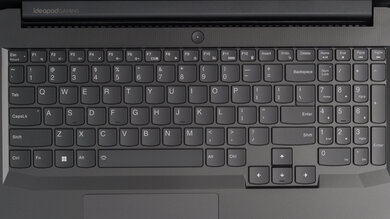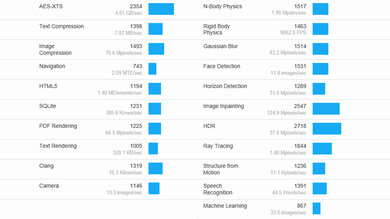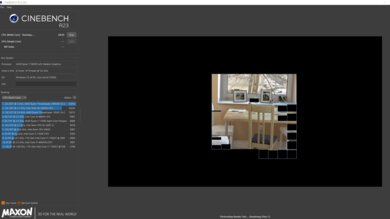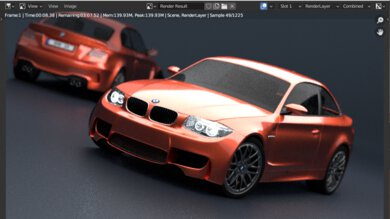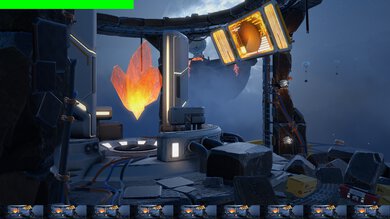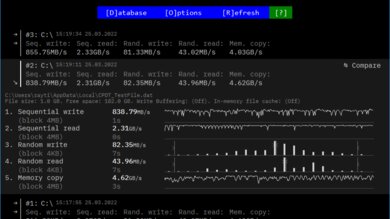The Lenovo IdeaPad Gaming 3 (2021) is a 15.6-inch budget gaming laptop. It's available with an AMD Ryzen 5 5600H or Ryzen 7 5800H CPU and various NVIDIA discrete GPUs, from a GeForce GTX 1650 to an RTX 3060. Memory and storage max out at 16GB and 1TB, respectively, and both are user-upgradeable. There are three 1080p display options with different refresh rates: 60Hz, 120Hz, and 165Hz. Ports include two USB-As, one USB-C, an HDMI, Ethernet, and a 3.5mm headphone jack. The USB-C doesn't support charging or video output. It has a full-size keyboard with a Numpad, Wi-Fi 6 wireless connectivity, and a 45Wh battery (60Wh on models with an RTX 3060). You can see our unit's specifications and the available configuration options in the Differences Between Variants section below.
Our Verdict
The Lenovo IdeaPad Gaming 3 15 is okay for school use. It's a little bulky and heavy, and its battery only lasts around five hours of light use. However, it provides a good user experience with a decently sharp screen, a comfortable keyboard, and a responsive touchpad. It also has enough processing power to handle demanding workloads, making it suitable for students in technical fields like graphic design and 3D animation. Unfortunately, you can't use its USB-C port to charge the laptop or output a video signal to an external display, and the fans get pretty loud when performing intensive tasks.
- Feels well-built.
- CPU and dedicated GPU can handle demanding workloads.
- Keyboard feels great to type on and doesn't cause fatigue.
- Decent webcam video quality for video calls.
- Battery lasts only a little over 5 hours of light productivity.
- Display doesn't get bright enough to combat glare.
- Not the most portable due to bulky size and weight.
- USB-C doesn't support charging or video output.
The Lenovo IdeaPad Gaming 3 15 is good for gaming. Its AMD Ryzen CPU and NVIDIA dedicated GPU can deliver a smooth gaming experience at 1080p, though you have to make sure to get 16GB of memory as the 8GB configuration will result in lower frame rates and frequent stutters. Thankfully, it's easy to access the internals for upgrades, so you can do it yourself later on. Its 120Hz display delivers a relatively clear image in fast-moving scenes; however, its slow response time causes noticeable ghosting. There's a 165Hz panel option available if you want even smoother gameplay, though you'll need to go up to an RTX 3060 to make the most of it. There's very little performance loss when performing intensive tasks, but the fans get pretty loud.
- 120Hz refresh rate with FreeSync support.
- User-upgradeable memory and storage drive.
- Minimal performance loss on CPU.
- No performance loss on GPU.
- Slow response time causes noticeable ghosting.
- Single rank x16 memory module hampers performance.
- Loud fans under load.
The Lenovo IdeaPad Gaming 3 15 is mediocre for media consumption. It isn't very portable as it's a little bulky and heavy, and its battery only lasts about three hours of video playback. The speakers sound fairly natural and well-balanced, but they don't have much bass to produce a thumping sound and don't get very loud. The 60Hz and 120Hz display options look washed out due to their narrow color gamuts, but you can get a 165Hz panel with full sRGB coverage, which will look much better. Unfortunately, all the display options are IPS panels with low contrast, which aren't ideal for dark room viewing.
- Screen handles reflections well.
- 100% sRGB panel option.
- Flicker-free backlight helps reduce eye strain.
- Blacks look gray in dim settings and colors look washed out.
- Quiet speakers.
- Display doesn't get bright enough to combat glare.
- Not the most portable due to bulky size and weight.
- Battery lasts only 3 hours of video playback.
The Lenovo IdeaPad Gaming 3 15 is great as a workstation. Its AMD Ryzen CPU and NVIDIA dedicated GPU can handle demanding workloads, like video editing, 3D animation, and graphic design. Its performance over time is outstanding as there's only a little bit of thermal throttling on the CPU and none on the GPU, although the fans are fairly loud under load. Sadly, the port selection is mediocre as its single USB-C port doesn't support charging or video output and can only transfer data at USB 3.2 Gen 1 speed of up to 5Gbps.
- CPU and dedicated GPU can handle demanding workloads.
- User-upgradeable memory and storage drive.
- Minimal performance loss on CPU.
- No performance loss on GPU.
- Single rank x16 memory module hampers performance.
- USB-C doesn't support charging or video output.
- Loud fans under load.
The Lenovo IdeaPad Gaming 3 15 is decent for business use. It feels well-built even though it's entirely plastic, but it's a bit bulky and heavy, so it isn't the easiest thing to carry around. Also, its battery lasts only about five hours, which means you'll have to bring the proprietary charger with you because you can't charge the laptop via USB-C. The keyboard feels comfortable to type on and doesn't cause fatigue, the touchpad tracks all movements and gestures well, and the webcam captures a decent image for video calls. Its AMD Ryzen CPU can easily handle most productivity tasks like text formatting, web browsing, spreadsheets, and presentations.
- Feels well-built.
- Keyboard feels great to type on and doesn't cause fatigue.
- Decent webcam video quality for video calls.
- Battery lasts only a little over 5 hours of light productivity.
- Display doesn't get bright enough to combat glare.
- Not the most portable due to bulky size and weight.
Changelog
- Updated Feb 29, 2024: Added mention of the Lenovo LOQ 15 (2023) as an alternative with longer battery life in the Battery section.
- Updated Dec 07, 2023: Converted to Test Bench 0.8.2.
- Updated Nov 03, 2023: Converted to Test Bench 0.8.1.
- Updated Apr 12, 2023: We've updated the review to improve clarity and readability.
Differences Between Sizes And Variants
We tested the Lenovo IdeaPad Gaming 3 15 (model 82K200UYUS) with an AMD Ryzen 7 5800H CPU, an NVIDIA GeForce RTX 3050 dedicated GPU, 8GB of memory, and 1256GB of storage. The screen, CPU, GPU, memory, and storage are configurable; you can see the available options in the table below. Our review applies only to variants with a model number starting with '82K2'. We've reviewed the Intel-based Lenovo IdeaPad Gaming 3i (2021) separately.
| Screen |
|
| CPU |
|
| GPU |
|
| Memory |
|
| Storage |
|
| Color |
|
You can see our unit's label here.
Popular Laptop Comparisons
The Lenovo IdeaPad Gaming 3 15 is among the better budget gaming laptops on the market in terms of build quality as well as the quality of its keyboard and touchpad. However, its port selection is lacking, and its use of single rank x16 memory makes its overall performance worse than expected, so you have to pay more to upgrade the memory if you want to get the most out of the CPU and GPU.
For more options, check out our recommendations for the best gaming laptops, the best laptops for college, and the best business laptops.
The Lenovo LOQ 15 (2023) is better than the Lenovo IdeaPad Gaming 3 (2021) for most uses. The LOQ 15 is available with faster Ryzen CPUs and NVIDIA 40-series GPUs, resulting in much better gaming performance with higher and more consistent frame rates. It has more ports, longer battery life, and variable refresh rate support to reduce screen tearing. Additionally, the LOQ 15 stays cooler and quieter under load and doesn't throttle as much as the IdeaPad Gaming 3.
For gaming, the Lenovo IdeaPad Gaming 3 (2021) is better than the Acer Nitro 5 15 (2020). The IdeaPad Gaming 3 is available with newer and more powerful CPUs and GPUs that can push out higher frame rates, as well as a brighter and more colorful display with a higher 165Hz refresh rate. The IdeaPad Gaming 3 also has a much better keyboard that works more reliably, as the Nitro 5's doesn't register some keystrokes at times. On the other hand, the Nitro 5 has a much longer battery life, lasting twice as long for light productivity and video playback, and it's cooler and quieter under load.
The HP Victus 15 (2022) and the Lenovo IdeaPad Gaming 3 (2021) are very similar. The HP is available with faster Intel 12th Gen. CPUs; however, the Lenovo has a higher-end NVIDIA RTX GeForce 3060 GPU option, which outperforms all the GPUs available on the HP. The HP has a better port selection, as it includes a USB-C and an HDMI 2.1 port, which the Lenovo lacks. The HP doesn't get as hot or loud as the Lenovo under load, but its CPU throttles slightly more than the Lenovo.
The Dell G15 (2022) and the Lenovo IdeaPad Gaming 3 (2021) are both budget gaming laptops. In terms of user experience, the Lenovo comes out ahead because it has a sturdier build as well as a better keyboard and touchpad. However, the Dell's Intel 12th Gen. CPUs perform better than the Lenovo's AMD Ryzen 5000-series processors, giving you better frame rates in games. The Dell also has higher-end configuration options, like a QHD 240Hz display and an NVIDIA GeForce RTX 3070 Ti GPU.
Test Results

The Lenovo IdeaPad Gaming 3 15 has a simple and plain design. Its angular shape adds some gamer aesthetic, but it's otherwise bland and doesn't stick out in a professional work environment. It's entirely plastic and is only available in the Shadow Black color scheme. The speakers are on the bottom, and there are vents on both sides of the laptop as well as on the bottom.
The build quality is good. It's entirely plastic, but it feels solid, with only some flex in the display and almost none in the keyboard deck. The plastic doesn't feel particularly premium, though, and while the finish doesn't scratch easily, it does pick up oil from handling, especially on smoother surfaces.
The hinge is okay. It feels smooth when opening and closing the laptop, and it's stable, though there's a little bit of screen wobbling when using the device on an uneven surface or typing aggressively. You can't open the lid with one hand because there's too much resistance, which is somewhat disappointing as it's a nice quality-of-life feature that adds a premium feel to the laptop.
The Lenovo IdeaPad Gaming 3 is reasonably portable. It isn't overly bulky, but it's pretty heavy. In contrast, the power adapter is relatively compact and fits easily into most bags.
The serviceability is excellent. Accessing the internals is very easy; you only have to remove ten Philips screws and undo the clips with a pick or prying tool. The Philips screws are of two different lengths, but they're easily identifiable. Models with an NVIDIA GeForce RTX 3060 have a second M.2 storage slot instead of a 2.5-inch hard drive slot. You can see the service manual here.
The Lenovo IdeaPad Gaming 3 15 is available with the following displays:
- 15.6" IPS 1920 x 1080 60Hz
- 15.6" IPS 1920 x 1080 120Hz
- 15.6" IPS 1920 x 1080 165Hz
All three displays look the same in sharpness, so choose based on the refresh rate, brightness, and color performance (color gamut) you want. The pixel density is decent at this resolution and screen size, so images and text look fairly sharp. Its 16:9 aspect ratio is good for gaming and media consumption, but it feels a little too short for productivity, meaning you have to scroll more when reading a document or website. If you want a gaming laptop with a sharper QHD display option, check out the Dell G15 (2022).
The 120Hz panel has a relatively slow response time, causing noticeable blur trails behind moving objects. The 60Hz panel will produce an even blurrier image and likely more ghosting, so it's best to avoid it unless you're on a strict budget or used to playing at 60Hz, like on a gaming console. The 165Hz will provide the smoothest experience, but you'll need to pair it with at least an RTX 3050 GPU, preferably an RTX 3060, to make the most of the high refresh rate.
The 120Hz panel doesn't get bright enough to combat glare, so it's best to avoid using it in a well-lit environment or outdoors in broad daylight. The brightness is also inconsistent, as the top corners are dimmer, between 210 and 213 cd/m², and the bottom corners range from 233 to 237 cd/m². The center of the screen is the brightest at 240 cd/m². If you like viewing content in the dark, the screen gets very dim to help reduce eye strain.
The 60Hz panel has the same advertised brightness of 250 cd/m², but the 165Hz has an advertised 300 cd/m² brightness.
The Lenovo IdeaPad Gaming 3 has good reflection handling. Its matte anti-reflective coating does a great job of diffusing bright, direct reflections like a lamp or open window during the day. It doesn't reduce the intensity of the light source, so direct reflections are still very distracting when viewing dark content, albeit not as much when viewing bright content with the screen at max brightness. Bright ambient lighting creates a haziness that makes dark scenes hard to see, but it isn't an issue when viewing bright scenes.
The Lenovo IdeaPad Gaming 3 has a sub-par horizontal viewing angle. The image is a lot dimmer from the side, almost too dim to even share casual content with someone else. It's best to be close to or directly in front of the screen to get the best accuracy. The 60Hz and 165Hz panels will likely perform similarly.
The vertical viewing angle is mediocre. The image looks dim and washed out from above and below. It's fine if you're only looking at a text document, but you have to look at the screen straight on if accuracy is important, which can be hard in tight places, like on an airplane with small tray tables.
The Lenovo IdeaPad Gaming 3 15's display accuracy is mediocre out of the box. Most colors are inaccurate due to the panel's narrow color gamut. The white balance is decent, though, and the color temperature is extremely close to the standard 6500K target. The gamma doesn't quite follow the sRGB curve; most scenes appear darker than they should, while bright scenes appear too bright. The 165Hz panel with full sRGB coverage likely has better accuracy out of the box.
The 120Hz panel has a poor color gamut. It doesn't even have full coverage of the commonly-used sRGB color space, resulting in dull and washed-out colors in most content. It also has very limited coverage of the wider color spaces like Adobe RGB, DCI P3, and Rec. 2020, making it unsuitable for color-critical work. The 60Hz panel has a similar color gamut, but the 165Hz panel has an advertised 100% sRGB coverage.
The Lenovo IdeaPad Gaming 3 has a great keyboard. It feels spacious and has a fairly standard layout, so it doesn't take long to get used to typing on it. The plastic used for the keycaps is unremarkable; it doesn't feel premium, but it isn't bad. The keys are stable, have a lot of travel, and don't require much force to actuate. They don't have the most satisfying tactile feedback, but they aren't mushy either. Overall, it feels great to type on and doesn't cause fatigue over time. You can toggle between two backlight brightness levels or turn it off completely.
The Lenovo IdeaPad Gaming 3 has a good touchpad. It's fairly large, and it feels smooth and solid even though it's plastic. It tracks all movements and gestures well, and there aren't any issues with palm rejection or actions like dragging and dropping. The click mechanism feels mushy, though, and you can only click towards the bottom of the touchpad.
The Lenovo IdeaPad Gaming 3 15 has decent speakers. They sound relatively natural and well-balanced, with a lot of emphasis in the high-mid frequencies to bring out vocals and lead instruments. However, they don't have much bass or treble extension, so they're better suited for spoken content than music or movies. They don't get very loud, but on the upside, the sound quality doesn't degrade much at max volume.
The Lenovo IdeaPad Gaming 3's webcam captures a decent image with good exposure and color reproduction. However, it's a bit noisy, and it loses most of the fine details due to its low resolution. The microphone doesn't pick up much background noise, and voices sound loud and clear, albeit slightly nasal. The privacy cover also disables the webcam and microphone at the software level so that it can't record audio when shut.
The Lenovo IdeaPad Gaming 3 AMD has a mediocre port selection. Its USB-A ports support only USB 3.2 Gen 1 data transfer speed (up to 5Gbps). Its single USB-C port also supports USB 3.2 Gen 1 data transfer speed, and you can only use it for data, meaning you can't use it to charge the laptop or output a video signal to an external display. If you want a similar laptop with Thunderbolt 4 support, check out the ASUS TUF Dash F15 (2022).
The wireless adapter is a MediaTek Wi-Fi 6 MT7921.
The Lenovo IdeaPad Gaming 3 is available with the following CPUs:
- AMD Ryzen 5 5600H (6 cores/12 threads, up to 4.2GHz, 16MB)
- AMD Ryzen 7 5800H (8 cores/ 16 threads, up to 4.4GHz, 16MB)
Both are high-power processors typically found in gaming laptops and mobile workstations and can handle demanding workloads like gaming, video editing, and 3D animation. The Ryzen 7 5800H is faster than the Ryzen 5 5600H, especially in multi-threaded applications. The performance difference isn't huge in GPU-limited games, but it's noticeable in CPU-intensive games, like real-time strategy and open-world games. For production workloads like video editing or programming, it's best to go with the Ryzen 7 5800H as it'll be able to complete tasks much faster.
The Lenovo IdeaPad Gaming 3 is available with the following dedicated GPUs:
- NVIDIA GeForce GTX 1650 with 4GB of GDDR6 VRAM
- NVIDIA GeForce RTX 3050 with 4GB of GDDR6 VRAM (85W TGP)
- NVIDIA GeForce RTX 3050Ti with 4GB of GDDR6 VRAM (85W TGP)
- NVIDIA GeForce RTX 3060 with 6GB of GDDR6 VRAM (90W TGP)
The NVIDIA GeForce GTX 1650 is an entry-level dedicated GPU that can get you roughly 60 fps at 1080p with low settings. The RTX 3050 is a decent step up from the GTX 1650, allowing you to run graphically demanding games at high settings while still maintaining around 60 fps or slightly above. The RTX 3050Ti is only marginally better than the RTX 3050, less than a 10% performance increase on average. The RTX 3060 is faster than the RTX 3050 and will get you higher frame rates, around 80 to 100 fps in demanding games.
Performance aside, the RTX GPUs have features that the GTX 1650 lacks, like ray-tracing and DLSS (Deep Learning Super Sampling). DLSS is a feature that aims to increase frame rates by rendering the game at a lower resolution and subsequently upscaling it to minimize any loss in visual quality. However, it usually works better at higher resolutions and depends heavily on each game's implementation, meaning you may see only a small increase in frame rate at 1080p or none at all when enabled. As for ray-tracing, it isn't worth enabling on an RTX 3050 and 3050Ti due to its high-performance cost. It may be worth it on the RTX 3060, but only if you use DLSS to make up for the performance loss.
There's NVIDIA Optimus support, meaning the system can automatically switch the graphics processing to the AMD Radeon integrated GPU in light workloads to extend battery life. However, there isn't a MUX switch, so all information processed by the dedicated GPU needs to pass through the integrated GPU before it gets to the display, which results in a performance loss of up to 15%. If you want a gaming laptop with a MUX switch, check out the Lenovo Legion 5 Gen 6 15 (2021).
You can configure the Lenovo IdeaPad 3 Gaming with 8GB or 16GB of memory. It's best to opt for 16GB for the best gaming experience. 8GB isn't enough for some games and will cause stutters, and the 8GB is in a single-channel configuration, which impacts performance significantly on AMD Ryzen systems. This laptop also uses single rank x16 memory, which doesn't perform as well as rank x8 memory due to a smaller bandwidth. The use of this slower memory doesn't affect every game or application; it's more of an issue in CPU-bound scenarios. There are reports of users getting rank x8 memory in their units, but Lenovo doesn't specify which type is in each model, so it's impossible to know what you'll get until you receive the device.
You can configure the Lenovo IdeaPad 3 Gaming with a 256GB, 512GB, or 1TB PCIe NVMe SSD. You can also get models with a 256GB or 512GB PCIe NVMe SSD coupled with a 1TB 2.5-inch 5400rpm hard drive, except for models with an NVIDIA GeForce RTX 3060.
The Lenovo IdeaPad Gaming 3 has an excellent overall score in Geekbench 5. The AMD Ryzen 7 5800H has outstanding single-thread and good multi-thread performance; however, it's worse than expected. It scores nearly the same in the single-thread test as the AMD Ryzen 5 5600H in the HP Pavilion Gaming Laptop 15 (2021) and much lower in the multi-thread test even though the Ryzen 7 5800H has more cores and threads. The lower-than-expected scores are likely due to the laptop having single-rank x16 memory in a single-channel configuration, which can affect performance in some memory-sensitive tasks like file compression. In short, the AMD Ryzen 7 5800H, and even the Ryzen 5 5600H, are very capable CPUs that can handle demanding production workloads, but you'll have to replace the memory modules to get the most out of them.
As for the GPU compute, the NVIDIA GeForce RTX 3050 has an excellent score, making it suitable for intensive tasks like video editing and 3D animation. That said, it's best to go with the RTX 3060 if you want the smoothest experience and fastest render times. The GTX 1650 can get the job done, but you'll likely experience some stutters and frame drops here and there, and it'll take longer to complete tasks.
The results above are scores obtained in the Balanced power profile. The Performance mode only boosts graphical performance slightly.
The Lenovo IdeaPad Gaming 3 with an AMD Ryzen 7 5800H performs exceptionally well in Cinebench R23, making it suitable for professional-level rendering or other related workloads. It even beats the Apple MacBook Pro 16 (2021) with an M1 Max SoC in multi-thread performance. The AMD Ryzen 5 5600H's multi-thread performance isn't as good because it has fewer cores and threads, but it can still get the job done, just slower.
The Lenovo IdeaPad Gaming 3's performance in Blender is outstanding. Although the AMD Ryzen 7 5800H can render the simple bmw27 scene relatively quickly, it's much faster to use the dedicated GPU, especially an RTX GPU that supports NVIDIA Optix API hardware acceleration.
The Lenovo IdeaPad Gaming 3's Basemark GPU score is great and within the expected range for the NVIDIA GeForce RTX 3050. The NVIDIA GeForce GTX 1650 is more of an entry-level GPU and roughly 35% slower than the RTX 3050, in the same ballpark as the HP Pavilion Gaming Laptop 15 (2021). The RTX 3050Ti is only marginally better than the RTX 3050, not enough of a performance increase to make much difference. However, the RTX 3060 performs significantly better than the RTX 3050, giving you upwards of 35% to 40% better performance. Essentially, the RTX 3050 can get you around or slightly above 60 fps in graphically demanding games at high settings. You can get 60 fps with a GTX 1650, but you'll have to play with low settings. The RTX 3060 will give you the smoothest gameplay with much higher frame rates, likely around 80 to 100 fps in most games at medium or high settings.
The Lenovo IdeaPad Gaming 3's storage drive performance is outstanding. Its fast read and write speeds make the system feel more responsive, shortening the time that it takes to boot up, launch apps, and transfer files. Its sequential read speed is particularly impressive, which helps with game loading times. The 2.5-inch 5400rpm hard drive is much slower, so it's best to install regularly-played or multi-player online games on the SSD along with the operating system and use the hard drive for the rest. The speed of the SSD may vary depending on the size, as larger SSDs tend to perform better.
The Lenovo IdeaPad Gaming 3 has poor battery life. Although the system switches to the integrated graphics for lighter workloads, it still doesn't last long enough to get you through a typical school or workday. Battery life for video playback is even shorter, giving you only enough time to get through one or two movies at the most. Gaming or demanding tasks like video editing drain the battery very quickly, so you'll have to use the laptop plugged in most of the time. The RTX 3060 models have a 60Wh battery, but it likely won't result in longer battery life as the RTX 3060 runs at a higher wattage than the RTX 3050. Battery life varies greatly depending on the laptop's configuration, as higher-end GPUs and displays with a faster refresh rate consume more power. If you want a gaming laptop with a longer battery life, check out the Lenovo LOQ 15 (2023).
The Lenovo IdeaPad Gaming 3 performs poorly in Borderlands 3. The game is extremely choppy at high settings, and while the average frame rate is much higher at low settings, it still stutters a lot. That said, this isn't indicative of the AMD Ryzen 7 5800H and an NVIDIA GeForce RTX 3050's performance, as it's an issue caused by other factors, such as the unit's limited amount of memory, the memory density, and the fact that it's running in a single-channel configuration. If you upgrade the memory modules, you can expect the performance to be closer to that of the HP Victus 16 (2021). The GTX 1650 can reach 60 fps, but only if you turn down the graphical settings to near minimum. The RTX 3060 will perform much better, with frame rates closer to 70 or 80 fps at high settings.
Civilization VI runs decently well on the Lenovo IdeaPad Gaming 3 with an AMD Ryzen 7 5800H and NVIDIA GeForce RTX 3050. The gameplay is smooth at high settings, and while there are some stutters, they don't happen often and are barely noticeable. That said, the performance is worse than expected, as a laptop with this CPU and GPU configuration is capable of pushing out much higher frame rates. Every CPU and GPU configuration can run this game smoothly, though you'll have to turn down some settings on a GTX 1650 model to get 60 fps. The average turn time is decent and within the expected range. It'll be longer on models with an AMD Ryzen 5 5600H, but not by much.
CS:GO runs well on the Lenovo IdeaPad 3 Gaming, but again, it's worse than expected for a configuration with an AMD Ryzen 7 5800H and an NVIDIA GeForce RTX 3050. It's still very playable, though, even at high settings. Every CPU and GPU configuration of the Lenovo IdeaPad Gaming 3 can run this game smoothly.
Shadow of the Tomb raider runs poorly. The average frame rate only reaches 60 fps at low settings, and even then, it still stutters a lot. However, you can improve performance slightly by enabling DLSS on models with an RTX GPU. The GTX 1650 can reach 60 fps, but you'll have to turn down some settings. The RTX 3060 will run this game smoothly without any issues.
The Lenovo IdeaPad Gaming 3's thermal and noise handling is sub-par. The keyboard deck is a little warm even when idle, and it gets very hot under load, though the hottest spot is above the keyboard, away from where most people rest their hands. The fans are near silent when idle and are only audible if you put your ears next to the laptop. They do get fairly loud under load; however, it isn't annoying as it just the sound of heavy airflow, not a high-pitch whine. The posted results are readings taken in the Balanced power profile. The Performance mode makes the fans slightly louder. If you want a similar laptop that doesn't get as hot or loud under load, check out the Intel-based Lenovo IdeaPad Gaming 3i (2021).
The performance over time is outstanding. The CPU's temperature is a little high, and there's some throttling, but it's fairly minimal and only noticeable in demanding workloads that push the CPU to near 100% utilization. The GPU doesn't throttle at all as its temperature is relatively low, which is great for gaming as most games rely more on GPU than CPU performance. The other CPU and GPU configurations will likely perform similarly.
The Lenovo IdeaPad Gaming 3 has many pre-installed applications, including:
- Lenovo Hotkeys: Lets you create keyboard macros.
- Lenovo Vantage: Helps keep the BIOS and drivers up to date. It also lets you view the system's status and warranty information, as well as access various power profiles.
- Lenovo Welcome: Introductory app containing general information about the laptop for new users.
- Nahimic: SteelSeries-branded audio customization and configuration utility.
- Nahimic Companion: Helps keep the Nahimic application up to date.





